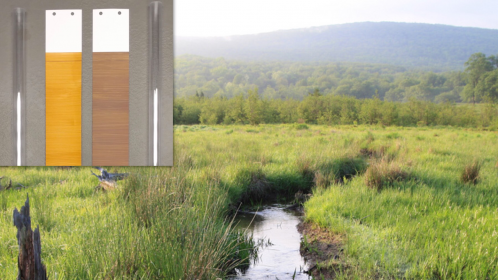A researcher at University of Maryland Department of Environmental Science and Technology has invented a new way to measure the quality of wetland soils. Since wetlands are heavily protected, classifying an area as a wetland is an important and often difficult job for assessors because confirmation of the presence of wetland soils requires proof that certain biogeochemical processes are happening underground.

New tool (top left) for wetland classification (Source)
Dr. Martin Rabenhorst wanted to find a better way to test wetland soils. The old way uses disposable PVC pipes coated with iron-oxide paint and inserted into the ground. The pipes are left in the ground for about a month, and then the assessors see how much paint was removed. If 30% or more of the paint was removed, the soil is assumed to be anaerobic and therefore has the characteristics of wetland soil. That method presents several problems. First, it produces a lot of plastic waste, as the pipes cannot be reused. Second, paint can strip off as the pipe as its inserted into the ground, and third, because the tube is three dimensional, it is time consuming to assess how much paint was lost.
Rabenhorst developed a new method where reusable plastic tubes are used to insert thin vinyl films into the ground. The films are coated with the iron-oxide paint and are protected by the tube, preventing paint from coming off during insertion. The tube is removed and the film stays in the ground to react with the soil. After a month, assessors can dig out the two-dimensional films and easily scan and analyze them, giving a much more accurate assessment of soil reactivity. In addition, storing the films only takes up 5% of the space of the traditional one-use tubes.
The invention was nominated for UMD Invention of the Year, making it “one of nine inventions recognized with a nomination in a field of over 170 new inventions disclosed during 2017” (source).
